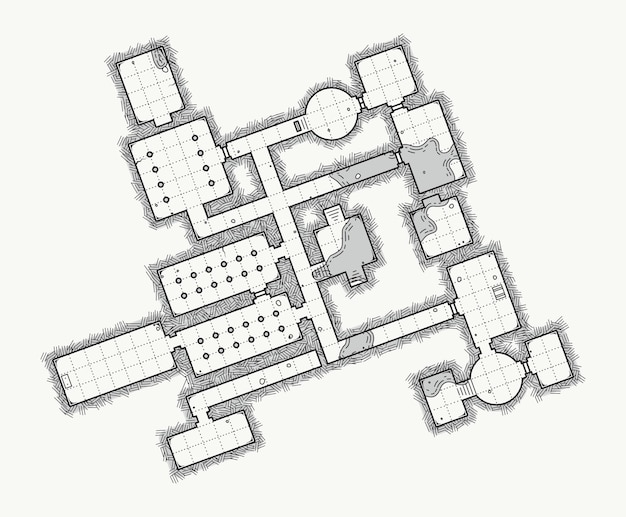Level Design Fundamentals: Crafting Engaging Gameplay in 3 Months

Achieving proficiency in level design fundamentals: crafting engaging gameplay experiences in 3 months involves mastering core principles like player flow, pacing, and iteration, allowing designers to create compelling game environments efficiently and effectively for a captivating user experience.
Embarking on the journey of level design fundamentals: crafting engaging gameplay experiences in 3 months might seem ambitious, yet with a structured approach and dedication, it’s an achievable goal for aspiring game developers. This guide explores the essential concepts and practical steps to transform theoretical knowledge into tangible, playable experiences that genuinely captivate players.
Understanding the Core Pillars of Level Design
Level design is not merely about arranging assets; it’s an intricate art form that blends technical prowess with creative storytelling. At its heart, it aims to guide players through engaging scenarios, modulate their emotions, and present challenges that feel both fair and rewarding. Mastering this craft within a three-month timeframe requires a clear understanding of its foundational elements and how they interweave to form cohesive gameplay.
Pacing and Flow: The Player’s Journey
Effective level design hinges on carefully controlling the player’s experience, often referred to as pacing and flow. This involves orchestrating a series of events, challenges, and moments of respite to maintain engagement and prevent fatigue. A well-designed level feels intuitive, even when presenting complex obstacles.
- Rhythm: The alternating sequence of tension and release within a level.
- Guidance: Subtly directing the player’s attention and movement using environmental cues.
- Obstacle Introduction: Gradually introducing new mechanics or enemies to avoid overwhelming the player.
- Emotional Arc: Designing moments that evoke specific feelings, from excitement to contemplation.
Consider how classic games manipulate these elements. A sudden ambush might follow a calm exploration phase, re-energizing the player and demanding quick reflexes. The transition from wide-open spaces to narrow corridors can heighten tension, preparing the player for an impending challenge. Each element contributes to a holistic experience, ensuring the player remains immersed and motivated to progress through the game world.
Player Mechanics Integration: More Than Just Movement
Levels are built around the player’s abilities and the core gameplay mechanics. A good level design seamlessly integrates these elements, providing meaningful opportunities for the player to utilize their toolkit. This isn’t just about movement; it includes combat, puzzle-solving, and interaction with the environment. Every challenge encountered should implicitly encourage the player to master their character’s capabilities, reinforcing the core loops of the game.
For instance, a level might introduce a new jumping puzzle that requires precise timing, compelling the player to improve their platforming skills. Or, a combat arena could be designed to encourage specific weapon usage or strategic positioning. The level becomes a teacher, providing organic opportunities for skill development. This iterative process of introducing mechanics, providing challenges, and rewarding mastery is crucial for building engaging gameplay experiences.
Ultimately, the core pillars of level design—pacing, flow, and mechanics integration—are not disparate concepts but interconnected components that work in harmony. By attentively crafting each of these elements, designers can construct levels that are not only aesthetically pleasing but also deeply satisfying and memorable for players, providing a solid foundation for expedited learning in the three-month timeline.
Deconstructing Levels: A Practical Approach
To swiftly grasp level design, a practical and systematic approach to deconstructing existing levels is invaluable. This involves dissecting successful designs to understand their underlying principles and mechanisms. It’s akin to an aspiring architect studying masterworks to understand structural integrity and aesthetic appeal. This process moves beyond surface-level observations to uncover the strategic decisions that make a level compelling.
Analyzing Spatial Arrangement and Environmental Storytelling
Spatial arrangement goes beyond simply placing objects; it’s about defining paths, creating choke points, and establishing visual hierarchies that guide the player. Consider how elements like lighting, contrasting textures, and distinct landmarks are used to direct attention and indicate points of interest. Environmental storytelling, meanwhile, uses the physical layout to convey narrative or historical context without explicit dialogue or cutscenes.

- Visual Cues: Subtle indicators that point players towards objectives or critical paths.
- Progression Path: How the level leads the player from one area to another, maintaining a sense of journey.
- Narrative Elements: Objects or scenes within the environment that tell a story about the world.
- Architectural Language: The consistent use of design elements that communicate function or importance.
By dissecting levels with these aspects in mind, one can observe how a dilapidated building suggests a past conflict, or how well-lit paths draw the player’s eye towards an exit. This depth of understanding helps in replicating and innovating upon successful design patterns. For instance, observe how a level might subtly use a broken wall and debris to hint at a previous battle, inviting players to piece together the narrative themselves. This active engagement enhances immersion far more than explicit exposition. The careful arrangement of objects can also reinforce a game’s theme, making the level feel like a natural extension of the lore, rather than just a backdrop for action.
Identifying Challenge Progression and Reward Systems
Every engaging level features a carefully structured progression of challenges. This isn’t arbitrary; it follows a deliberate curve, starting with simpler obstacles and gradually escalating in complexity. Simultaneously, reward systems play a crucial role in validating player effort and encouraging continued engagement. These can range from tangible items to abstract feelings of accomplishment.
Examine how different types of challenges are introduced—puzzles, combat encounters, or navigation tests—and how they build upon previously learned mechanics. Is there a natural increase in difficulty? Are new enemy types or environmental hazards introduced at appropriate intervals? Simultaneously, analyze the rewards: are they balanced with the effort required? Rewards can be health packs, new abilities, lore entries, or simply the satisfaction of overcoming a difficult obstacle. A well-placed reward reinforces positive behavior and motivates the player to continue their journey.
For example, a sudden increase in enemy density might be followed by a valuable collectible, making the intense encounter feel worthwhile. Or, solving an intricate puzzle could unlock a new section of the map, providing both progress and a sense of discovery. The symbiotic relationship between challenge and reward needs to be finely tuned to keep players invested and prevent frustration. Understanding these dynamics by deconstructing existing levels provides invaluable insight into crafting your own compelling gameplay experiences.
Iterative Design: The Key to Rapid Improvement
In the accelerated timeline of level design fundamentals: crafting engaging gameplay experiences in 3 months, iteration is not just a process but a philosophy. It acknowledges that the first draft of any design is rarely perfect and that continuous refinement through testing and feedback is paramount. Embracing iteration allows designers to quickly identify flaws, experiment with alternatives, and steadily enhance the player experience within a compressed timeframe.
Prototyping and Playtesting: Learning by Doing
Prototyping involves creating rough, functional versions of levels to quickly test core concepts. These aren’t meant to be polished; their sole purpose is to validate ideas and identify issues early. Playtesting, where others interact with your prototypes, provides invaluable external feedback, revealing aspects you might have overlooked. The faster you can prototype and playtest, the quicker your learning curve will be.
- Rapid Blockouts: Using simple geometric shapes to define the level layout.
- Placeholder Assets: Utilizing basic models and textures to convey scale and function.
- Targeted Feedback: Asking specific questions during playtesting to get actionable insights.
- Version Control: Tracking changes to allow for easy rollback and comparison of iterations.
During initial prototyping, focus on macro-level elements like flow, combat arenas, and overall pacing. Don’t get bogged down in visual details. A simple greybox can reveal fundamental issues with pathing or enemy placement far more efficiently than a fully textured environment. For example, a playtester might consistently get lost in a seemingly straightforward section, indicating a need for clearer visual cues. Or, they might find a combat encounter too easy or too difficult, prompting adjustments to enemy AI or environmental cover. Each playtest session is a learning opportunity, providing empirical data to inform subsequent design decisions. This continuous cycle of creation, testing, and refinement is fundamental to rapid improvement in level design.
Gathering and Implementing Feedback Effectively
Feedback is the lifeblood of iterative design. However, simply gathering comments isn’t enough; designers must learn to discern actionable insights from subjective opinions. This requires active listening, asking clarifying questions, and prioritizing changes based on their potential impact on the player experience. Not all feedback needs to be implemented, but all feedback warrants consideration.
Categorize feedback into themes: Is there a recurring issue with navigation? Do players consistently struggle with a particular enemy type? Focus on addressing core problems that significantly hinder enjoyment or progression. Sometimes, a single piece of critical feedback can unlock a cascade of improvements, revealing a fundamental flaw in the level’s core concept. For instance, if multiple playtesters complain about a particular jump being too difficult, it might indicate poor platforming design rather than player inadequacy. Prioritize issues that affect a broad range of players and significantly impact the gameplay loop. The ability to effectively process and act upon feedback distinguishes a capable level designer from one who merely creates environments. Iteration, fueled by meaningful feedback, is the engine that drives mastery in level design.
Tools of the Trade: Software and Workflow Efficiency
Efficiency in level design, especially within a stringent three-month learning period, heavily relies on mastering the right tools and establishing an optimized workflow. Beyond artistic talent, understanding the technical pipeline—from conceptualization to in-engine implementation—is crucial. Familiarity with industry-standard software not only streamlines the creative process but also makes designs feasible within practical production constraints.
Choosing the Right Game Engine and Editor
Selecting an appropriate game engine is perhaps the most significant decision early on. Engines like Unity and Unreal Engine offer robust level editors and extensive feature sets, making them ideal for both beginners and experienced developers. The choice often depends on the type of game you intend to create and the availability of learning resources. Both engines provide visual scripting options that can accelerate prototyping, reducing the need for extensive coding knowledge in the initial stages.
Unity’s user-friendly interface and vast asset store make it a strong contender for indie developers and those focused on mobile or 2D games. Unreal Engine, known for its powerful rendering capabilities and Blueprint visual scripting system, is often preferred for high-fidelity 3D games. Dedicate time to thoroughly explore the chosen engine’s level editor. Learn its hotkeys, snap tools, and how to manipulate geometry efficiently. Proficiency with your chosen editor will drastically cut down on development time, allowing more iterative design cycles.
Additionally, understand how to import and manage assets within the engine. While initially, you might rely on simple blockouts, knowing how to integrate models, textures, and sound files is essential for building a more complete environment. Many online tutorials and official documentation sources are available to help accelerate this learning process for both Unity and Unreal Engine, providing a solid technical foundation for your design endeavors.
Streamlining Workflow: From Concept to Blockout
An efficient workflow ensures that creative ideas translate smoothly into functional level layouts. This often begins with conceptualization—sketching out ideas on paper or using digital painting tools—before moving into initial blockouts within the game engine. The transition between these phases should be fluid, allowing for rapid experimentation and revision.

- Pre-visualization: Sketching or creating mood boards to define the level’s atmosphere and goals.
- Greyboxing: Building the level using basic geometric primitives to test scale and flow.
- Modular Design: Creating reusable level components to accelerate construction.
- Asset Management: Organizing and naming assets consistently for easy access and collaboration.
Adopt habits that promote efficiency, such as consistent naming conventions for files and folders, and regular saving. Understand the principles of modular design, where parts of a level can be reused and rearranged, saving significant time. For example, a single corridor segment or a set of modular building pieces can be duplicated and snapped together to form intricate structures much faster than individually modeling each element. Leverage the engine’s built-in tools for snapping, aligning, and duplicating objects. These seemingly small efficiencies accumulate, making a significant difference over a three-month period. An optimized workflow means spending less time on technical hurdles and more time on the creative aspects of crafting engaging gameplay.
Player Psychology and Engagement Techniques
Beyond the technical aspects of building environments, understanding player psychology is paramount in level design fundamentals: crafting engaging gameplay experiences in 3 months. Great levels don’t just present challenges; they manipulate player emotions, guide their decisions, and keep them invested. This involves applying principles of human behavior to create experiences that resonate on a deeper level, ensuring sustained engagement and a memorable journey.
Guiding the Player: Visual and Auditory Cues
Players often need subtle guidance within a level to navigate effectively and understand objectives. Relying solely on UI elements can break immersion; instead, effective level designers use environmental cues that feel organic and intuitive. Visual cues, such as distinct lighting, splashes of color, or prominent landmarks, draw the player’s eye towards important areas or paths. Auditory cues, like distant sounds of combat or environmental ambiance, can alert players to impending threats or interesting locations off-screen.
Consider how a bright, glowing object naturally attracts attention, signaling an important pickup or objective. Or how a distinct sound of a monster roaring in the distance primes the player for an upcoming encounter. These cues are not explicit instructions but subtle suggestions that allow players to feel smart for “discovering” the path or anticipating events. This sense of self-discovery reinforces player agency and deepens immersion. The art lies in making the guidance unobtrusive, allowing players to feel like they are exploring freely while still being subtly directed towards the intended progression path, ensuring a fluid and intuitive experience.
Difficulty Curves and Emotional Pacing
Managing the difficulty curve is critical to keeping players engaged without leading to frustration or boredom. A well-designed level gradually introduces complexity, allowing players to adapt and master new skills. Simultaneously, emotional pacing controls the intensity of the experience, ensuring a balanced mix of thrilling moments, periods of calm, and moments of anticipation.
- Tutorialization: Introducing mechanics in safe environments before escalating challenges.
- Challenge Gates: Obstacles that require players to master previous skills to progress.
- Breather Moments: Sections of low intensity that allow players to regroup or appreciate the environment.
- Climax and Resolution: Building towards a major challenge, followed by a sense of accomplishment.
Avoid sudden spikes in difficulty that feel unfair, as this can lead to player dropout. Instead, introduce a new enemy type in isolation, and then slowly integrate it into more complex combat scenarios. Similarly, vary the emotional intensity. A tense stealth section might be followed by a beautiful vista, offering a moment of awe and calm before the next challenge. This emotional rollercoaster keeps the player invested, preventing monotony and ensuring that each segment of the level feels purposeful. By carefully mapping out the difficulty and emotional journey, level designers can create experiences that are not only playable but also deeply satisfying and memorable, demonstrating a nuanced understanding of player psychology within the tight learning schedule.
Case Studies and Inspiration: Learning from the Best
To truly excel in level design, especially within a compressed three-month learning period, it’s essential to look beyond theoretical principles and analyze successful levels in popular games. Case studies offer concrete examples of how fundamental concepts are applied in practice, providing invaluable insight and inspiration. Learning from the best involves dissecting their techniques, understanding their design choices, and adapting these lessons to your own projects.
Dissecting Iconic Levels: “De_Dust2” and “Black Mesa”
Certain levels have achieved iconic status because of their masterful design. De_Dust2 from Counter-Strike, for instance, is a prime example of balanced multiplayer level design, while Black Mesa from Half-Life showcases brilliant single-player environmental storytelling and pacing. Analyzing such levels reveals common principles that contribute to their enduring appeal.
- De_Dust2 (Counter-Strike):
- Balance: Symmetrical paths, varied cover, and clear engagement zones.
- Flow: Multiple routes leading to objectives, allowing for strategic decision-making.
- Readability: Distinct visual cues for Terrorist and Counter-Terrorist sides.
- Black Mesa (Half-Life):
- Pacing: Gradual introduction of mechanics, alternating combat and exploration.
- Environmental Storytelling: The decaying facility tells a narrative without dialogue.
- Player Guidance: Subtle visual cues lead the player through complex environments.
In De_Dust2, every angle and piece of cover feels deliberate, fostering strategic depth in competitive play. The level’s simplicity belies its tactical complexity, allowing players to master its nuances over countless hours. For Black Mesa, the narrative is woven directly into the environment; a blood smear on the wall or a broken piece of equipment tells a story, deepening immersion without relying on cutscenes. Observe how these levels introduce and escalate challenges, guide player movement, and subtly communicate information. This deep dive into masterpieces provides a practical blueprint for crafting your own compelling experiences within the limited timeframe.
Extracting Universal Design Principles
While specific game genres might dictate certain design patterns, many principles of effective level design are universal. Regardless of whether you’re designing a sprawling open world or a linear puzzle, concepts like clear communication, controlled pacing, and meaningful player choice remain crucial. Learning to extract these universal principles allows for their application across diverse projects.
One universal principle is the “rule of three,” where a mechanic is introduced, then iterated upon, and finally combined with other mechanics for a complex challenge. Another is the concept of “affordance,” where the environment intuitively suggests how it can be interacted with (e.g., a ledge inviting a jump). Identifying how these principles manifest in successful games, even those outside your preferred genre, broadens your design vocabulary. For example, the precise platforming challenges in a 2D indie game might use similar principles of clear visual communication as a large-scale 3D combat arena. By distilling these core ideas, you equip yourself with a versatile toolkit that can be applied to any level design challenge, accelerating your development from novice to proficient designer in a short sprint.
Beyond the Basics: Advanced Concepts for Rapid Growth
As you master the level design fundamentals: crafting engaging gameplay experiences in 3 months, it’s wise to begin exploring more advanced concepts. These aren’t necessarily complex technical skills, but rather nuanced design philosophies that differentiate truly exceptional levels from merely functional ones. Integrating these ideas early, even in a simplified form, can significantly elevate the quality of your work and accelerate your growth as a designer.
Leveraging Verticality and Dynamic Elements
Many beginner level designers focus solely on horizontal progression. However, incorporating verticality—designing levels with multiple elevations, paths above and below, and opportunities for vertical movement—adds significant depth and strategic complexity. Dynamic elements, such as moving platforms, destructible environments, or time-sensitive events, further enhance engagement by introducing unpredictability and requiring constant adaptation from the player.
Consider how a level that forces players to navigate rooftops and subterranean tunnels feels distinct from a flat, single-plane design. Verticality can introduce new combat angles, create opportunities for stealth, or simply make exploration more interesting. Similarly, a bridge that collapses mid-traversal or a weather system that alters visibility adds layers of challenge and excitement. These elements demand a higher level of design foresight but yield much richer gameplay experiences. By thoughtfully integrating verticality and dynamic components, levels become more than just pathways; they become living, evolving spaces that constantly surprise and challenge the player, demonstrating a refined understanding of design.
Fostering Replayability and Player Agency
A sign of truly great level design is replayability—the impulse for players to return to a level even after completing it. This often stems from fostering a strong sense of player agency, offering meaningful choices and allowing for varied experiences within the same environment. Levels that offer multiple viable paths, optional objectives, or hidden secrets naturally encourage exploration and repeat playthroughs.
Think about a level with two distinct routes to the objective: a direct, combat-heavy path, or a longer, stealth-focused one. This choice allows players to tailor their experience to their preferred playstyle, enhancing agency. Furthermore, hidden collectibles, secret areas, or environmental puzzles that offer unique rewards incentivize players to meticulously explore every nook and cranny. Replayability can also be driven by emergent gameplay, where the level’s systems interact in unpredictable ways based on player actions, leading to unique and memorable moments each time it’s played. By designing with player choice and exploration in mind, you move beyond mere progression to create experiences that players genuinely want to revisit, showcasing a deeper mastery of level design principles in a surprisingly short timeframe.
| Key Concept | Brief Description |
|---|---|
| 🚀 Pacing & Flow | Orchestrating level intensity and player movement for immersive experiences. |
| 🛠️ Iterative Design | Rapid prototyping, playtesting, and feedback cycles for continuous improvement. |
| 🧠 Player Psychology | Understanding cues, difficulty curves, and agency to maintain engagement. |
| 📈 Tool Mastery | Proficiency with game engines and efficient workflows to bring designs to life. |
Frequently Asked Questions
▼
Proficiency with game engines like Unity or Unreal Engine is crucial. They are the primary tools level designers use to build, test, and iterate on their creations. Understanding their interfaces, tools, and workflows significantly accelerates the design process and directly impacts how quickly you can translate ideas into playable experiences. Hands-on experience is key to internalizing design principles.
▼
Yes, it’s possible to grasp the fundamentals within three months through focused effort. This requires a structured learning plan, consistent practice, and a strong emphasis on iterative design and feedback. While mastery takes years, a solid foundation can be built surprisingly quickly by prioritizing core concepts and applying them through practical projects. Dedication is your strongest ally.
▼
Level design focuses on creating engaging gameplay spaces: player flow, pacing, challenges, and objectives. Level art, conversely, is about the aesthetics: texturing, lighting, asset placement for visual appeal, and atmosphere. While often intertwined, a level designer prioritizes function and player experience, whereas a level artist focuses on making the environment visually compelling and consistent with the game’s art style.
▼
To get meaningful feedback, conduct targeted playtests with clear objectives. Ask specific questions about flow, difficulty, and clarity, rather than general “what do you think?” queries. Observe players’ actions and frustrations. Seek feedback from other designers, and learn to differentiate constructive criticism from subjective preferences. Implementing feedback effectively is as important as gathering it.
▼
Starting with 2D level design can often be less daunting and allows you to focus on fundamental principles like pacing, platforming, and enemy placement without the complexities of 3D navigation and camera control. However, if your ultimate goal is 3D level design, transitioning sooner might be beneficial. Both offer valuable transferable skills, so choose what sparks your interest most initially.
Conclusion
Mastering level design fundamentals: crafting engaging gameplay experiences in 3 months is an ambitious yet entirely achievable endeavor for those committed to the craft. By systematically focusing on core principles like pacing, mechanics integration, and player psychology, coupled with aggressive iteration and skillful tool utilization, aspiring designers can rapidly develop a strong foundational understanding. The journey involves not just building spaces, but understanding human behavior, anticipating player actions, and constantly refining through feedback. The three-month timeline serves as a powerful accelerator, pushing you to integrate knowledge actively and practically. The skills acquired in this concentrated period will equip you to tackle more complex design challenges, laying the groundwork for a rewarding career in game development, proving that with strategic effort, impactful learning is well within reach.





